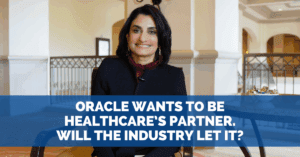In healthcare IT, vendors are often accused of building walls instead of bridges. Systems don’t make it easy to share data, payer integration often adds friction, and the back office rarely connects to the bedside. At the 2025 Oracle Health and Life Sciences Summit (OHLSSummit), Oracle made the case that it wants to be the opposite: open, collaborative, and willing to share the sandbox.
At OHLSSummit, Seema Verma, EVP and GM of Oracle Health, outlined how the company is positioning itself as a partner-first player in healthcare. From tackling payer–provider friction to embedding clinical trials in the patient portal, and from connecting ERP and supply chain to the EHR, her message was clear: Oracle’s future rests on openness, not walls.
Key Takeaways
- Oracle Bets on an Open Ecosystem – Verma emphasized Oracle Health’s plan to let customers share AI agents and clinical pathways, backing up the promise that Oracle won’t wall off innovation
- Automating Prior Authorization – Oracle announced efforts to bridge the payer-provider gap, starting with new tools to streamline prior auth.
- Clinical Trials in the Patient Portal – Verma previewed a 2027 vision where clinical trial matching happens inside the EHR, sparked by stories of patients nearly missing life-saving opportunities.
- Bringing ERP, HR, and Supply Chain into Healthcare – Oracle is extending its enterprise suite into healthcare so staffing, supplies, and financial systems connect directly to the clinical workflow.
Open Ecosystems as a Competitive Edge
Verma didn’t shy away from the idea that Oracle’s credibility rests on being willing to collaborate. Her argument was simple: no single vendor owns the future of healthcare, and those who cling too tightly risk losing trust.
“We have the humility to say that nobody has a hold on innovation,” said Verma. “We want our customers, and we want patients to be able to avail themselves of the best products out there.”
Bridging the Payer-Provider Gap
Oracle’s desire to bring the healthcare ecosystem together extended to its push to reduce friction between payers and providers. The company announced new automation tools aimed at simplifying and streamlining prior authorization and reimbursements. Verma described automation as the path to reduce the endless back-and-forth, cut administrative costs, and, most importantly, ensure “patients are not going to have delays in care.”
Clinical Trials Can’t Be Left to Chance
At the end of Verma’s Summit opening keynote, she invited Michelle Brown to the stage to tell her story. Brown has a son, Aidan, who has been battling Stage 4 cancer since he was just 5 years old (he is now 20). After bouncing around from specialist to specialist, Aidan was finally diagnosed and that started her years-long journey navigating the complex healthcare system to save her son.
During her research into pediatric cancers, Brown happened upon an online support group. That group led to a chance encounter and a clinical trial that ultimately saved Aidan’s life. But had that introduction to a “friend-of-a-friend-of-a-friend” not happened, Aidan might not be here to enjoy his dream of going to college.
“We shouldn’t leave clinical trial eligibility to chance,” Verma said, pointing to Oracle’s plan to embed trial matching directly into the patient portal so families can see opportunities immediately – without relying on luck.
Watch the opening keynote here: Seema Verma on AI in Action: Oracle Health and Life Sciences Summit 2025
Healthcare’s Future Isn’t Just the EHR
For all the focus on clinical systems, Verma pointed out that real improvement depends on tying in ERP, HR, and supply chain tools. Ensuring the right surgeon, supplies, and implantable devices are available is central to care.
“Healthcare can’t be solved with a single point solution,” stated Verma. “We’re not going to solve healthcare problems with just the EHR. We also need other components We need a suite of solutions. The suite is the EHR, the portal, revenue cycle, but also ERP, supply chain, and HR.”
Partnership, Not Just Product
The announcements at OHLSSummit pointed to a clear strategy. Oracle wants to be known less as a single EHR vendor and more as a partner that brings payers, providers, and even competitors into the same ecosystem. Prior authorization, clinical trials, and ERP integration are the proving grounds for that vision. Oracle has set the table; the next move depends on who decides to sit down.
Learn more about Oracle at https://www.oracle.com/
Listen and subscribe to the Healthcare IT Today Interviews Podcast to hear all the latest insights from experts in healthcare IT.
And for an exclusive look at our top stories, subscribe to our newsletter and YouTube.
Tell us what you think. Contact us here or on Twitter at @hcitoday. And if you’re interested in advertising with us, check out our various advertising packages and request our Media Kit.
This article was developed with support from Burson Global. The views expressed remain those of the author.




